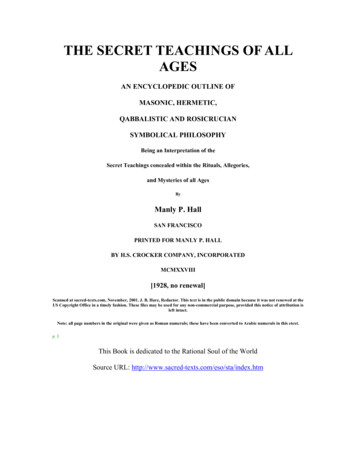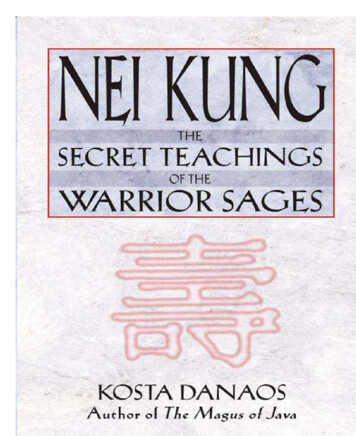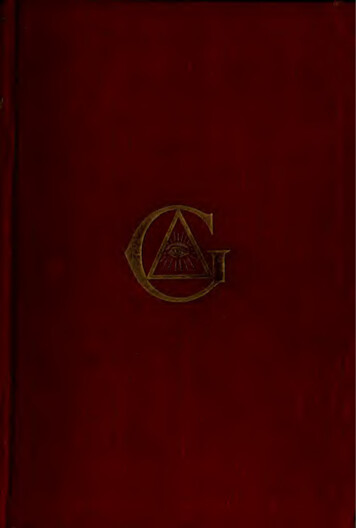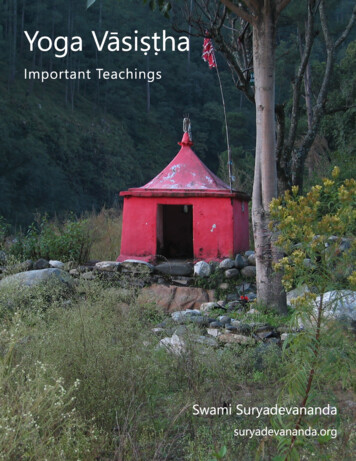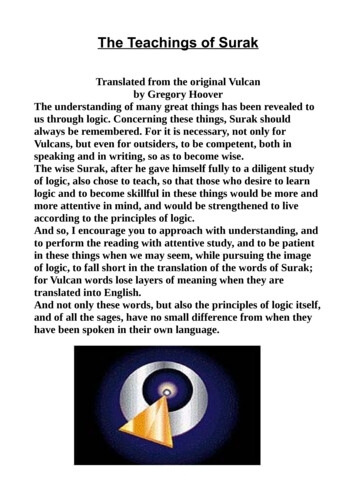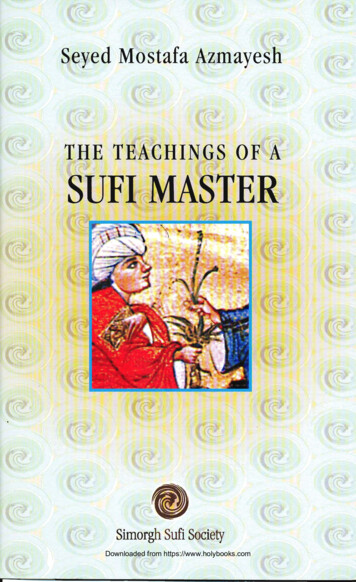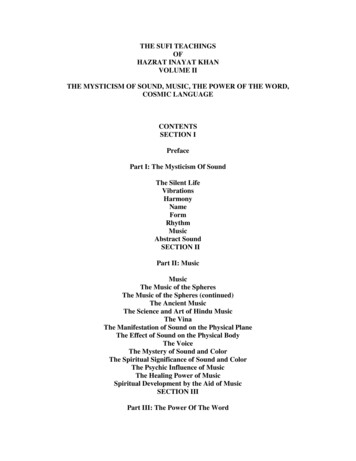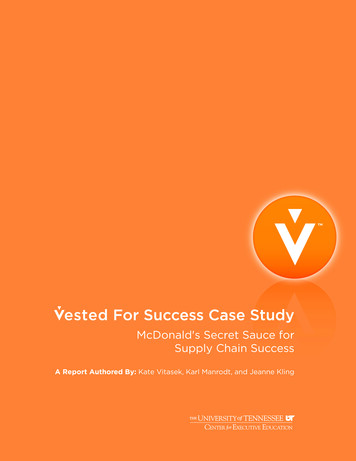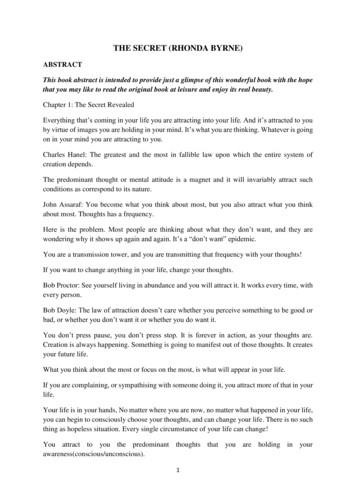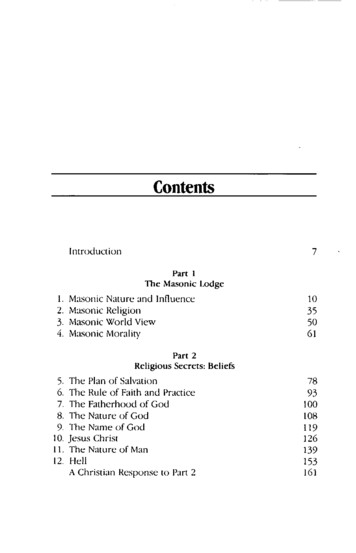
Transcription
ContentsIntroduction7Part IThe Masonic LodgeI. Masonic Nature and Influence2. Masonic Religion3. Masonic World View4. Masonic Morality10355061Part 2Religious Secrets: Beliefs56.7.8.910.11.12.The Plan of SalvationThe Rule of Faith and PracticeThe Fatherhood of GodThe Nature of GodThe Name of GodJesus ChristThe Nature of ManHellA Christian Response to Part 27893100108119126139153161
Part 3Religious Secrets: Practice13. Blaspheming God's Name14. Swearing Oaths15. Uniting All Religions16. Influencing the Church168178192202Part 4Mystical Secrets17.18.19.20.The OccultSpiritismMystery ReligionsDeception215231244254EpilogueThe Legacy of Christian MasonryNotesSelected ReferencesMasonry at a GlanceIndex of SubjectsIndex of Persons282317323325331
· As a fraternity, we are always ready to be judgedseverely and critically.Francis G. Paul, 33d Degree,Sovereign Grand Commander,7be Northern Light, May 19881Masonic Nature and Influenceasonry (also known as Freemasonry or 'The Lodge") is aMpowerful, old fraternal order that began early in the eighteenth century. According to most Masonic authorities, modernMasonry (also called "speculative" Masonry) can be traced tothe founding of the first Grand Lodge in London in 1717.'The Lodge is also a secret society. In fact, the Encyclopaedia Bn'tannica classifies it as the largest secret society in theworld. To maintain its secrets, Masonry uses symbolism, secretoaths, and secret rituals to instruct new members called "Initiates." Each new member swears during these secret ceremonies to remain loyal to the Lodge and its teachings. The teachingsinstruct each new candidate how he is to serve and the rewardshe can expect.In addition, Masonry views its mission in life as helping tobring the beliefs of all men into harmony-a harmony basedprimarily on Masonic teachings.' Two of these teachings formthe foundation of all Masonry.First is their belief in the universal fatherhood of God andbrotherhood of man. By thiS, Masons teach that all men-Muslims, Jews, Hindus, Mormons, BuddhiSts, and Christians--regardless of their personal religious views, are the spiritual sonsof God. Masonry's second foundational belief is that reformingpersonal character and practicing good works will secure God's10
Masonic Nature and InfluenceJJfavor. In other words, the Masonic Lodge clearly teaches thatthe good character and good works of a Mason will earn him aplace in the "Celestial Lodge Above" (i.e., heaven).THE NAllJRE OF MASONRYSeveral leading Masons have defined Masonry. Accordingto Alhert G. Mackey in Revised Encylopedia of Freemasonr)""All [Masons] unite in declaring it to be a system of morality, bythe practice of which its members may advance their spiritualinterest, and mount by the theological ladder from the Lodgeon earth to the Lodge in heaven. ".' Other respected Masonic authorities define Masonry in the following ways:"Masonry is the realization of God by the practice of Brotherhood.""'"It is a science which is engaged in the search after DivineTruth, and which employs symbolism as its method of instruction. " "[Masonry is] that religious and mystical society whose aim ismoral perfection on the basis of general equality and fraternity. "6"Freemasonry, in its broadest and most comprehenSive sense,is a system of morality and social ethics, a primitive religion and a philosophy of life . Incorporating a broadhumanitarianism, . it is a religion without a creed, beingof no sect but finding truth in all . It seeks truth butdoes not define truth. '"A man who becomes a Mason is defined by Masonic authoritiesas "one who has been initiated into the mysteries of the Fraternity of Freemasonry. ",On the other hand, defining Masonry presents us with adilemma. No single definition of Masonry is accepted by all Masons. This is because the practice of Masonry means many different (and sometimes contra!)') things to individual Masons.For some of its members, Masonry has become little more thana social club; for others, Masonry dominates their life and work.
12The Secret Teachings oJ the Masonic LodgeThis point is well stated by leading Masonic authority HenryWilson Coil in A Comprehensive View of Freemasonry:Nobody knows what Freemasonry is, or, if that statement bedeemed too strong, at least no one has been able to demon-strate that he knows the answer to the question. What one[Mason or Masonic authority] assem another of apparentlyequal ability doubt' or denies . Nor is this divergence ofopinion due to ignorance or lack of investigation, for con-flicts arise principally among the most zealous and erudite ofMasonic students. The Fraternity has no central authority todeclare its creed and no cenSor of books to check aberrations. Anyone, either within or without the Society, mayspeak or write about it what he wills, and many have takenadvantage of that liberty.'Coil proceeds to discuss the basic problem of definitionpresented by Freemasonry:Freemasonry has spread so widely, has expanded into somany degrees [more than 1,100 degrees according to Coil:,Masonic Encyclopedia, p. 600; cf. Encyclopaedia Britannica,Micropaedia, 15th ed., s.v."Freemasonry"], and has under-gone so many changes, to say nothing of having been subjected to so many diverse interpretations, that the question: Whatis Freemasonry? must first be answered by another question:When, where, and what phase of it? Though much of Masonicdoctrine has remained remarkably well fixed and stable, itslaws have changed, its degrees have changed, its ceremonieshave changed, its religion has changed, and doubtless theconcepts of it by its members have changed."Through its history Masonry has changed, and even todayMasonry worldwide is not uniform. This characteristic of Masonry presents an important issue that needs to be resolved atthe outset: Does Masonry's lack of a central authority make itincapable of being subject to legitimate criticism? The answer isno. The mere fact that Masonry has evolved historically or thatMasons disagree among themselves is irrelevant to the production of a factual analysis. Some Masons imply that because Masonry has no "official voice," some Masonic writers are onlyvoicing personal opinions that have no authority. Consider the
Masonic Nature and Influence13argument of Masonic historian Alphonse Cerza. Cerza claimsthat some Masons have advanced theories or made statemenL'that merely express personal views, implying that such viewsare not Masonic and therefore irrelevant to Masonry:Some Masonic authors have unintentionally supplied opponents of the Craft with some of their arguments. Dr. AlbertChurchward, J. S. N. Ward, W. L. Wilmshurst, Arthur Waite,and others have advanced theories and made statements thatexpress personal views. Some of their statements are notbased on fact, are mere theories, and are not generally ac-cepted by Masons. But the anti-Masons pick up these statements and hold them up to ridicule by stating that they arefrom book., of "Masonic authority." These anti-Masons havedifficulty in understanding that Freemasonry has no "officialvoice" and that freedom of thought and expression is one ofthe fundamental principles of the Order."Cerza cites the lack of a central authority in Masonry as areason critics have been able to quote Masons in their so-calledunfounded attacks. But the issue is, "Are what these Masonicwriters say true for Masonry'" It is not the fault of one who analyzes Masonry that Masonry has no central authority. But Masonry clearly has a specific history. Masonry clearly has a general consensus as to iL' world view. Even the leading Masonicauthority, Albert Mackey, has admitted "the doctrine of Freemasonry is everywhere the same. "" A, we have seen above, Coilhimself admits that much of Masonic doctrine "has remainedremarkably well fixed and stable."The real issue is whether or not the statements made bythese Masonic authorities are in harmony with what Masonryrepresents and constitutes, both historically and in terms of itsworld view. That is the only issue that needs to be decided. Masonry may not have a single human authority, but few Masonswill dispute that Masonry iL elf provides the authority. [n TheNewly-Made Mason, H. L. Haywood refers to the obligationsplaced upon the new Mason:I hereby solemnly and sincerely promise and swear that as abeginning Craftsman in the Masonry of the mind and as aNewly-Made Mason I will not permit myself to be led into
14Tbe Secret Teacbings of tbe Masonic Lodgemaking hasty conclusions. I promise and swear that I will notlisten to those who are not competent to teach me. Therewillbe nothing binding on me except the truth. If there be thosewho say one thing and if there be others who say the opposite thing, I will consider that it is Freemasonry itself whichfinally is to decide berween them."What we present in this book, therefore, is an analysis ofMasonry itself, as stated by Masonic authorities recommendedby at least half of the Grand Lodges in the United States. Werecognize that all of what is presented may not necessarily coincide with the individual beliefs of a given Mason. Some Masonshave no interest in the history and doctrines of Masonry. Someare unfamiliar with its occult aspects. But for others, Masonry isa religious world view that dominates their life and their work.Regardless of the fluid and sometimes historically contradictory nature of Masonry, there remains a solid core of beliefthat is central to the majority of Masonry and to which almost allMasonic writers appeal." We have examined this core belief,but we have done a great deal more. In examining Masonry insome depth, we have tried to show that the implications of Masonry extend far beyond what the average Mason might suspect.Before an individual supports Masonry with his oaths,vows, time, and money, he should acquire sufficient information as to the teachings and implications of his craft. It is onlythen that a rational decision can be made as to whether or notone can indeed support Masonry in good conscience. We havewritten this text in the hope that it will perform a genuine service to Masons so that this decision can be made intelligently.Further, we believe the material presented in this volume willbe a considerable help to everyone outside the Lodge whoneeds authoritative information on Masonry.DETERMINING TIiE AUTIiORlTATfVE SOURCES IN MASONRYMr. Bill Mankin, a 32d Degree Mason, admitted on national television that "The authoritative source for Masonry is TheRitual. The Ritual-what happens in the Lodge, what goes on. ""He was correct.
Masonic Nature and InfluenceJ5But Coil points out "the misconception that originallythere was somewhere one authorized ritual. The Masonic rituals were not created: they grew [historically] and there neverwas only one Masonic ritual; there have always been many. "00The question then becomes, "Who determines what the ritualwill consist of in each Masonic Lodge?" The answer is, theGrand Lodge of each state has the power to regulate the ritualpracticed in that Lodge. A Coil writes, it is "well understoodthat Grand Lodges are the highest Masonic authorities in bothlaw and doctrine. ""What must be recognized here is that, historically andworldwide, Ma onic ritual varies. But in contemporary American Masonry, it is highly uniform. Thus, if one examines Masonry historically, he will find that the Grand Lodges of eachstate have disagreed on many of the landmarks (principles ofMasonry) and precisely what should be included in the ritual.However, when one examines the different manuals containingthe current ritual for each state in America, it is apparent thatthe ritual and interpretations given are very close, if not identical. Therefore, the ritual in the Masonic manuals can be considered the authoritative teachings of the Lodge. Former Worshipful Master Jack Harris reveals: "In [all] other states . theprinciple and the doctrines are exactly the same. The wordingonly varies slightly. "'".In addition, the ritual itself is but the reflection of Masonicdoctrine. State by state the rituals may vary slightly, but the doctrines they are intended to convey are everywhere uniform. Forexample, Mackey states in his encyclopedia on Masonry thatin each Masonic Jurisdiction it is required, by the superin-tending authority, that the Ritual shall he the same; but itmore or less differs in the different Rites and Jurisdictions.But this does not affect the universality of Freemasonry. TheRitual is only the external and extrinsic form. The doctrine ofFreemasonry is evef)'\vhere the same. It is the Body which isunchangeable-remaining always and evcf)'where the same.The Rimal is but the aliter garment which covers this Body,which is subject to cominual variation. It is right and desir-able that the Ritual should be made perfect, and everywherealike. But if this be impossible, as it is, this at least will con-
16The Secret Teacblngs oJ the Masonic Lodgesole us, that while the ceremonies, or Ritual, have varied atdifferent periods, and still vary in different countries, thescience and philosophy, the symbolism and the religion, ofFreemasonry continue, and will continue, to be the samewherever true Freemasonry is practised. 19A vast amoum of Masonic literature is available to the researcher. This includes at least 100,000 volumes, among whichare a minimum of 600 analytical works giving a broad treatmemof the subject of Masonry." Also in prim are numerous exposesof Masonry by former members who have revealed virtually allthe secrets of the Craft (e.g., Byers, 'Harris, McQuaig, Ronayne,and Shaw). Thus, Masonry is a "secret society" only to thosewho have not read this literature.Which authors and books do Masons themselves recommend to outsiders as authoritative? In order to answer thisquestion, a lener was sem 10 each of the fifty Grand Lodges inAmerica. We addressed this leller to the Grand Master of eachLodge and asked him 10 respond to the following question: "Asan official Masonic leader, which books and authors do you recommend as being authoritative on the subject of Freemasonry?"Twenty-five of the Grand Lodges in the United States responded." A response of fifty percent is sufficiently high 10 suggest that the responses of OIher states would nOl have variedsignificantly. In OIher words, we may assume that these responses are normative for U.S. Masonry as a whole. Remember,for each state, no higher jurisdictional authority than its GrandLodge exists.Which authors were recommended by the Grand Lodgesas being authoritative for Masons?44 percem recommended Henry Wilson Coil36 percent Joseph Fon Newton32 percent Alben G. Mackey24 percent Carl H. Claudy24 percem H. L. Haywood20 percent Alphonse Cer7. l20 percent Roben F. Gould20 percent Allen E. Robens16 percent Alben Pike
--------Masonic Nature and Influence/7Other authors recommended included W. R. Denslow, R. V.Denslow, Charles C. Hunt, Bernardjones, Roscoe Pound,jamesAnderson, Henry C. Clausen, D. Darrah, Manly Hall, W. Hutchinson, M. M. johnson, Karl C. F. Krause, W. Preston, G. Steinmetz,J. H. Van Gorden, T. S. Webb, and Louis Williams.What individual books were recommended by the GrandLodges as being authoritative interpreters of Freemasonry?44 percent Coil's Masonic Encyclopedia, by Henry WilsonCoil36 percent The Builders, by joseph Fort NeWlon32 percent Mackey's Revised Encyclopedia of f"reemasol1ry, by Albert G. Mackey24 percent Introduction to Freemasonry, by Carl H.C1audy24 percent The Newly-Made Mason, by H. L. Haywood20 percent A Masonic Reader's Guide, by Alphonse Cerza20 percent History of Freemasonry, by Robert F. Gould20 percent The Craft and Its Symbols, by Allen E. Roberts16 percent Morals and Dogma, by Albert PikeNotice that the Grand Lodges recognize Coil, NeWlon, andMackey as the three leading Masonic authorities." For example,Masonic scholar Oliver D. Street observes that all Masons "willadmit that Dr. Albert G. Mackey was one of the leading scholarsof the Masonic world.""Albert Pike should also be listed among leading Masonicauthorities. The current Sovereign Grand Commander, C. FredKleinknecht, relates the following about this Masonic scholar inThe House of the Temple of the Supreme Council (a text extolling the headquarters of the Supreme Council, 33d Degree):"Albert Pike remains today an inspiration for Masons everywhere. His great book Morals and Dogma endures as the mostcomplete exposition of Scottish Rite philosophy. He will alwaysbe remembered and revered as the Master Builder of the Scottish Rite" (italiCS added)." Because of the Sovereign GrandCommander's lofty estimate, when conSidering the meaning ofthe higher degrees in the Scottish Rite, we often include whatAlbert Pike wrote. Masons cannot claim that Pike was onlyteaching his "own opinions."
18The Secret Teachings of the Masonic LodgeBecause of the high esteem in which these authors areheld by the Grand Lodges, they are typically the most frequent1y quoted in our analysis of Masonry. At the same time, we havetried not to neglect the other Masonic authors recommendedby the Grand Lodges. We have tried to quote fairly from asmany as possible. Masons must acknowledge that these authorsand books do represent their most authoritative interpreters ofFreemasonry. So if we are wrong, then the ritual itself and Masonry's highly esteemed authors are also wrong and should bediscarded by those in the Lodge.THE BLUE loDGE, THE ScornsHRITE,AND THE YORKRITEThe Blue Lodge is the parent, or mother, Lodge of Freemasonry. In the Blue Lodge are conferred the first three degrees: (I) the Entered Apprentice, where a man is initiated intothe beginning mysteries of the fraternity of Freemasonry; (2)the degree of Fellow Craft; and (3) the Master Mason Degree.Before they may proceed to the higher degrees, all men mustgo through the first three degrees of the Blue Lodge. But it ispossible to go through only the first one or two degrees.After passing the three degrees of the Blue Lodge, the candidate may choose not to proceed any further. Many, and probably most, Masons do stop with the first three degrees. But thecandidate may choose to proceed higher along one or both oftwo branches in Masonry.One branch is known as the Scottish Rite, which advancesby numerical degrees, beginning with the Fourth and endingwith the 32d, the 33d Degree being either active or honorary.The other major branch is the York Rite, which goes throughwhat are called the "Chapter," "Council," and "Commandery"degrees ending with the degree of Knights Templar.Anyone who passes the first three degrees and becomes aMaster Mason may visit other Blue Lodges. If a Mason is suspended or expelled from his Blue Lodge, that automatically severs his connection with all other Masonic bodies.Below we present a diagram of the three Blue Lodge degrees that every Mason must take, plus the optional degrees ofthe York and Scottish Rites:"
Blue LodgeI. Entered Apprentice2. Fellow Craft3. Master MasonScottish RiteYork RiteLodge of PerfectionChapter (Capitular Degrees)Mark MasterPast Master (Virtual)Most Excellem MasterRoyal Arch Mason4. Secret Master5. Perfect Master6. Intimate Secretary7. Provost & Judge8. Intendant of the Building9. Elu of the Nine10. Elu of the Twelve11. Elu of the Fifteen12. Master Architect13. Royal Arch of Solomon14. Perfect EluChapter Rose CroixCouncil (C1J1J1ic Degrees)Royal MasterSelect Master1516.17.IS.Knight of the East or SwordPrince of JerusalemKnight of the East & WestKnight Rose CroixCouncil of Kadosh19.20.Super Excellent Master21.22.23.24.Commandery (Chivalric Degrees) 25.26.27.Order of the Red CrossOrder of the Knights of MaltaGrand PontiffMaster of the Symbolic LodgeNoachite or Pruss ian KnightKn ight of the Royal AxeChief of the TabernaclePrince of the TabernacleKnight of the Brazen SerpentPrince of MercyKnight Commander of theTemple28. Knight of the Sun29 Knight of St. Andrew30. Kn ight KadoshC01l.f\is/olJ'Order of KnightsTemplar CommandeI)'31. Inspector Inquisilor32 Master of the Royal Secret33. (Active or Honorary)
20The Secret Teachings of the Masonic LodgeBesides the above degrees, numerous side degrees of Masonrymay be sought, and many affiliated, or appendant, organizationsexist. These are orders with specific memberships (youth,women, relatives, collegians) or goals (such as the Shriners, theAncient Arabic Order of Nobles of the Mystic Shrine). Thesewill be discussed later.THE RELHION OF ruE 8WE LoDGE TO ruE HIGHER DEGREESMost Masons believe that Blue Lodge Masonry makes oneas full or complete a Mason as one can (or needs to) be. But animportant fact must be noted. Although the Blue Lodge is Masonry, and although it is the Masonry of most Masons, it is notall that Masonry constitutes. Some Masons would view BlueLodge Masonry-at least as it is usually interpreted-as an initial or beginning form of Masonry. They maintain that the realsubstance of Masonry-its lifeblood-lies only in the higherdegrees and in the initiate's search for their true meaning.Some Masons would even consider Blue Lodge Masonry asmerely the cover of the book. These Masons would say that tounderstand Masonry truly, one must open the book and readwhat lies within the cover. But what one finds there will shockeven most Masons (see chapter 19).Sovereign Grand Commander Henry C. Clausen admits,"It must be apparent that the Blue Lodge . degrees cannot explain the whole of Masonry. They are the foundation . An initiate may imagine he understands the ethics, symbols and enigmas, whereas a true explanation of these is reserved for themore adept."" Another leading Masonic scholar admits:If you have been disappointed in the first three Degrees, asyou have received them, . . remember . . that these antiqueand simple Degrees now stand like the broken columns of aroofless Druidic temple, in their rude and mutilated greatness; in many parts, also, corrupted by time, and disfiguredby modern additions and absurd interpretations. They arebut Ihe entrance to the great Masonic Temple. Imaginenot that you will become indeed a Mason by learning what iscommonly called the "work," or even by becoming familiarwith our traditions. Masonry has a hisLOry, a literature, a phi-losophy. Its allegories and traditions will teach you much; but
Masonic Nature and Influence21much is to be sought elsewhere. The streams of learning thatnow now full and broad must be followed to their heads inthe springs that well up in the remote past, and you willtberefind tbe origin and meaning of Masonry. (Italics added)"For many Masons, the first three degrees of Masonry, then,are merely a stepping-stone to the higher "truths" of the Lodge.In fact, as in the ancient pagan mystery cults (which were alsodivided into the "lesser" and "greater" mysteries), many Masons will admit that the Blue Lodge teachings are purposely deceptive. They are intended to hide the real truths of Masonryfrom the initiate until such a time as he is "worthy" of receivingthem." It would seem, then, that Blue Lodge Masonry parallelsthe "lesser mysteries" while the York and Scottish rites parallelthe "greater mysteries." Under his discussion of the Third Degree of the Blue Lodge in Morals and Dogma, Albert Pike observes thatMasonry, like all the Religions, all the Mysteries, Hermeticismand Alchemy, conceals its secrets from all except the Adeptsand Sages, or the Elect Ithe wonhy I, and uses false explana·tions and misinterpretations of its symbols to mislead. . (()conceal the Truth, which it calls Light, from them, and todraw them away from it. Truth is not for those who areun w onhy.l9In other words, according to Pike, many Masons are uninformed about Masonry because the Craft has purposely kept thetruth from them. And lest Masons claim ·that Pike was only asserting his own opinions, remember the words of C. FredKleinknecht affirming that Pike's Morals and Dogma "enduresas the most complete exposition" of Scottish Rite Masonry.THE INFLUENCE OF MASONRYMasonry exists in 164 countries of the world. w Accordingto the Encyclopaedia Britannica, its membership of 6 millionqualifies Masonry as "the largest worldwide secret SOCiety."" Atleast 15,300 Lodges operate in the U.S., and more than 33,700Lodges exist around the world."
22Tbe Secret Teacbings of tbe Masonic LodgeFor example, in the Philippines there are 211 Lodges and15,037 Masons. England has more than 8,000 Lodges with a membership of more than 600,000. West Germany has 388 Lodgeswith 21,000 members, and Italy has 562 Lodges with 24,000members. Even Communist Cuba has 324 Lodges and 19,728members! In Canada, there are 183,000 members in 1,600 Lodges,and the u.s. boasts at least 4 million Masons in 15,300 lodges.More Masons live in California (188,535) than in Canada. Thereare 90,000 Masons in Georgia, 83,000 in Florida, 146,000 in Illinois, 88,000 in Massachusetts, 111,000 in Michigan, 220,000 inOhio, 206,000 in Pennsylvania, 75,000 in South Carolina, 206,000in Texas, and %,000 in Tennessee:"These large numbers is one reason Masonry has exertedsuch a considerable influence in American society and thechurch:One member of the Craft pointed out that there are at least160 organizations (which he did nor identify) that reqUiretheir members to also be initiates into the Masonic Fraternity.In 1948, The New Age boasted that some ten million adultswere linked directly, or were indirectly associated with thenation's three million Master Masons. The Scottish Rite publication estimated that "between one in five and one in 10 ofthe adult thinking population come directly within the circleof Masonic influence. "34Even in 1912 scholar Martin Wagner could observe in his critical treatment on Masonry that "Masonry, with its numerousoffsprings, is a powerful factor in our civilization, It is influencing our civic, our social, our family, and our moral and religious life far more than is generally realized."" Wagner's assessment remains true.Critic Paul A. Fisher, who has had considerable experiencein military intelligence and has been active in political life, refers to Masonry's "enormous influence in the world media" andlists several founders, publishers, and editors of American papers who are Masons, In the U.S., according to the leading Masonic magazine, The New Age, many members of the NationalPress Club are Masons. Historian Mildred Headings claims Masonry has influenced almost half of French periodicals, off and
Masonic Nature and Influence23on, during the late nineteenth and early twentieth centuries.'" Astandard source on religions, Hastings' Encyclopedia of Religion and Etbics, has correctly pointed out that "with the spreadof Freemasonry over the whole world, . [itl has become a potent factor in promoting a feeling of universal brotherhoodamong mankind. ""Finally, Fisher observes that Masons have dominated theU.S. Supreme Court from 1941-1971. From 1941-1946 the ratiowas 5 to 4; from 1949-1956 it was 8 to I; from 1957-1967 it was 6to 3 and from 1969-1971 it was again 5 to 4:'" He concludes thatsuch influence may have contributed to the high court's "determination to move the nation away from an emphasis on judeoChristian values in public life," helping to further secularize society and sustain "an epoch of revolutionary liberalism" with farreaching conscquenccs .19If Fisher's claims contain any substance, then addressingthe religious views, content, and goals of Freemasonry is not anidle task but is relevant to each of us. In the 13th Degree of theScottish Rite the oath reads, "I furthermore promise and swearto use eve I)' means in my puwer . . to contribute with all mymight to the . propagation of liberal ideas wheresoever I maybe."·wAccording to Masonic and Congressional records, as manyas fourteen U.S. Presidents have been Masons: George Washington,james Monroe, Andrew jackson,james Polk,james Buchanan, Andrew johnson, james Garfield, William McKinley, TeddyRoosevelt, William Howard Taft, Warren Harding, FranklinDelano Roosevelt, I-larry Truman, and Gerald Forel. An additional fourteen Masons have been Vice Presidents:'The influence of Masonry in contemporary governmentwas revealed by the Senate Congressional record of September9, 1987." In those proceedings, some members of the Senatejudiciary Committee had questioned the propriety of appointing Judge David Sentelle as a U.S. Circuitjudge for the Districtof Columhia. The objection was raised on the grounds that hewas a Mason.In response to this) a number of Senators who were Ma-sons vigorously protested. They felt it was unthinkable to question an appointee merely because he was a member of the
24The Secret Teachings oJ the Masonic LodgeLodge. They considered it "extraordinary," "totally unwarranted," "most absurd," and "galling and preposterous." These Senators were "astounded" and "aghast"In the debate, Masonic Senators Strom Thurmond andAlan Simpson, and Senate Majority Leader Roben Byrd, all ofwhom admitted pride of membership, revealed that Masonsconstituted Fony-one members of the Federal Judiciary Half the membership of the Senate Judiciary Committee Eighteen Senators, including Lloyd Bentsen, Sam Nunn, BobDole, Jesse Helms, John Glenn, and Mark Hatfield Seventy-six members of the House of Representatives, including former Speaker of the House Jim Wright, Claude Pepper,William Ford, Dan Glickman, and Trent Lott At least rwo Senators were 33d Degree Masons: Bob Dole andSenate Majority Leader Roben ByrdObjections from other Congressional members wereraised against questioning Masonry because "Masonry in thiscountry is the bedrock" and because being a Mason "simplymeans people who believe in God and love their fellow man."It is clear that Masonic influence extends to the highest levels ofNnerican government.Many famous and influential persons from all walks of lifehave been Masons: Protestant minister Norman Vincent Peale,"former Senator Howard H. Baker," former Congressman JackKempi' Irv
The Lodge is also a secret society. In fact, the Encyclopae . doctrine has remained remarkably well fixed and stable, its laws have changed, its degrees have changed, its ceremonies have changed, its religion has changed, and doubtless the concepts of it by its members have changed." Th
